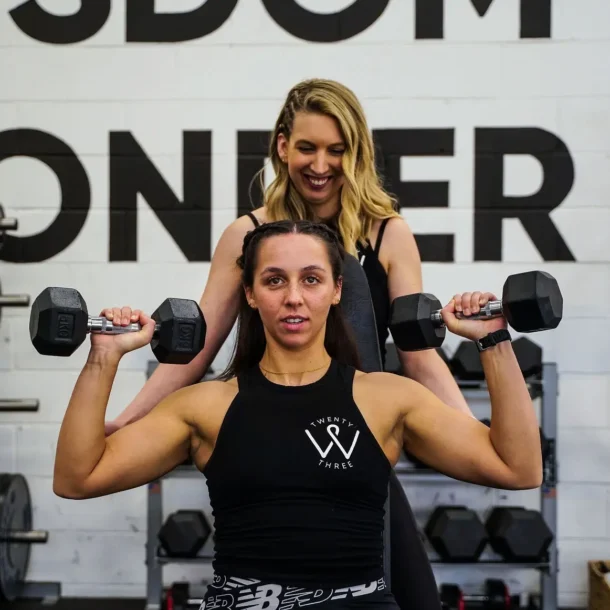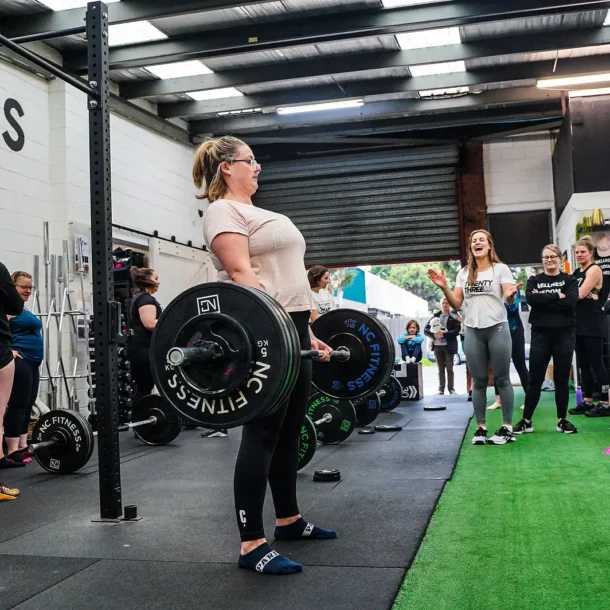

This week we asked our amazing trainers Asha to take over the MFD blog to chat muscle memory! Wow, take you time.. there is so much great information below!
The term ‘muscle memory’ is thrown about fairly liberally. You play a piece of music after months without practice, it’s muscle memory. A triumphant return to the netball court after a whole season away, all thanks to muscle memory. Memory is the ability of our cells to encode, store and retrieve information and this ability to return to an activity after a period of inactivity is down to motor learning in our central nervous system (CNS). The term ‘muscle memory’ as it relates to physical performance and aesthetics can be attributed to two physiological processes – hypertrophy and atrophy.
In simple terms, hypertrophy is an increase in muscle mass and atrophy, a decrease in muscle mass. In less simple terms, these two processes occur through changes in the rates of protein synthesis and proteolysis (protein breakdown) in your cells.
Protein synthesis is the generation of new proteins. Hypertrophic growth (continued contraction against a resistance) prompts the cells in your muscles to recruit myonuclei from muscle stem cells or ‘satellite cells’ located in the fibre basal lamina (a permeable sheath that separates sheets of differing cells.) Myonuclei is the name given to the nuclei (powerhouse) of muscle cells – where it stores the majority of its genetic information. As protein synthesis occurs in the nucleus of a cell, an increase in nuclei leads to a higher rate of protein synthesis. This leads to muscle hypertrophy as a higher number of nuclei means a higher amount of cell cytoplasm (the solution that sits inside a cells membrane around the nucleus) which leads to an increase in muscle fibre size.
During muscle atrophy, protein breakdown and selective cell apoptosis (cell death) occurs within the muscle fibre cells. The size of the muscle fibre would reduce proportional to the loss of myonuclei. Less myonuclei = less cell cytoplasm = a reduced muscle fibre size or atrophy.

How does this relate to muscle memory?
With consistent hypertrophy training, newly acquired myonuclei are shown to be more easily retained during periods of cell apoptosis/muscle atrophy. Over time and with consistency in training your muscle fibres retain an elevated number of myonuclei. As explained before, more myonuclei recruited for protein synthesis = more cell cytoplasm = larger muscles. This gradual elevation in the number of myonuclei in muscle fibres has been dubbed ‘muscle memory’.
Genetics play an important role in the ability to build muscle. Consistent weight training can help mitigate this however there are two genes which largely control your ability to build muscle. The IGF-1 (insulin like growth factor 1) and MSTN (myostatin) genes stimulate anabolic processes like muscle building in adults as well as healthy growth in children. In one experiment conducted by H. Lee Sweeney, a of molecular physiologist at the University of Pensylvania (see references for details), a group of mice injected with an extra copy of the IGF-1 gene, gained significant muscle and became up to 30% stronger.
Do we have any control over protein synthesis?
For the synthesis of new muscle protein there needs to be a sufficient amount of all 20 amino acids. There are 9 essential amino acids that we must obtain through diet and 11 non-essential amino acids that occur naturally in our bodies. BCAA’s (branched chain amino acids) are 3 amino acids (leucine, valine and isoleucine) out of the 9 essential ones that are precursors to protein synthesis in muscles. Consuming a BCAA supplement can be helpful in promoting protein synthesis however the long- term effects of this are reliant on the adequate presence of the other 6 essential amino acids.


How does training at 23W help?
Hypertrophy training occurs best with low volume training. Low volume means the total number of repetitions of one exercise is small, generally within the 3-8 rep range for 3-5 sets. This week at 23W you were doing straight sets for your compound lifts (back squat, bench press and deadlift) of 5 X 5 reps. This is an example of training for hypertrophy.
Another important aspect of muscle hypertrophy is getting enough rest. During an exercise your muscle is contracting against a resistance, this repeated contraction causes damage to the muscle fibres. When you rest those muscles, the fibres begin to recruit additional myonuclei from the satellite cells resulting in muscle hypertrophy. This is why we don’t attempt the big compound lifts more than twice a week.
To summarise
Consistent hypertrophy training and genetics are the main factors in muscle hypertrophy. With consistency we can achieve what is termed ‘muscle memory’ or the elevated level of myonuclei in our muscle fibres resulting in increased muscle size. A BCAA supplement can aid in protein synthesis provided there are adequate levels of the other 6 essential amino acids in our diet.
Glossary of terms
Protein synthesis – the generation of new protein molecules through amino acid synthesis and DNA transcription and translation.
Proteolysis – the breakdown of protein molecules back into amino acids.
Hypertrophy – muscle growth.
Atrophy – a reduction in muscle size.
Myonuclei – the plural term for the nucleus of a muscle cell.
Myonucleus – a single nucleus of a muscle cell.
Nucleus – the ‘powerhouse’ of a cell where most genetic information is stored.
Amino acids – an organic compound that when chained together create protein molecules.
BCAA – Branched chain amino acids (part of the 9 essential amino acids), long chains of amino acids that create protein molecules.
Written by Asha Khan
References
https://www.ncbi.nlm.nih.gov/pmc/articles/PMC5568273/
https://www.scientificamerican.com/article/muscles-genes-cheats-2012-olympics-london/

Ange Drake is an personal trainer, women’s empowerment coach and fitness blogger in the northern suburbs of Melbourne. She is the director of one of the few womens’ only strength training gyms in Melbourne, 23W. Ange helps women to learn how to use strength based training, nutritional strategies and a positive mindset to transform their bodies, relationship with food and mind.
Can’t decide which of our packages is best suited for you? Take our questionnaire to help you decide!





